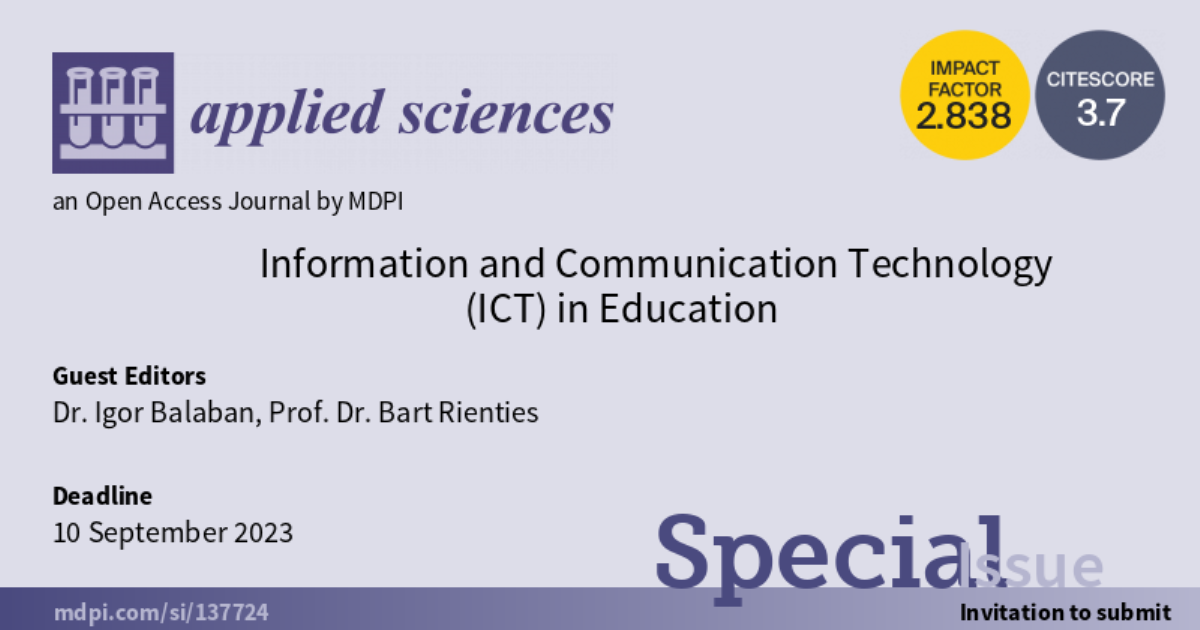Information and Communication Technology (ICT) in Education
A special issue of Applied Sciences (ISSN 2076-3417). This special issue belongs to the section "Computing and Artificial Intelligence".
Deadline for manuscript submissions: closed (10 September 2023) | Viewed by 55320

Special Issue Editors
Interests: e-learning; technology enhanced learning; information technology; student modelling; learning environments
Special Issue Information
Dear Colleagues,
COVID-19 has accelerated the shift to blended or fully online learning environments, enforcing educational institutions to embrace technology and offer their students an online or at least blended learning experience. A large amount of data became accessible through LMS but has so far generally not been analyzed in a proper manner nor used to improve the efficiency of teaching and learning. Institutions usually do not consider such data to drive their strategy, nor are teachers required to use the data to improve their teaching practice.
In this respect, in this Special Issue, we would like to tackle new approaches in creating learning environments that should be smarter, more inclusive, and involve emerging technologies that will boost the digital skills of students and bring them a more personalized experience.
Submissions should therefore focus on the following topics:
- Artificial intelligence in learning;
- Applied robotics in education;
- Automated approaches to create smart and inclusive learning environments for blended and online learning;
- Emerging technologies in education;
- Learning analytics and big data in learning environments;
- Learning strategies for smart learning environments;
- Using wearables to enhance the learning experience.
Dr. Igor Balaban
Prof. Dr. Bart Rienties
Guest Editors
Manuscript Submission Information
Manuscripts should be submitted online at www.mdpi.com by registering and logging in to this website. Once you are registered, click here to go to the submission form. Manuscripts can be submitted until the deadline. All submissions that pass pre-check are peer-reviewed. Accepted papers will be published continuously in the journal (as soon as accepted) and will be listed together on the special issue website. Research articles, review articles as well as short communications are invited. For planned papers, a title and short abstract (about 100 words) can be sent to the Editorial Office for announcement on this website.
Submitted manuscripts should not have been published previously, nor be under consideration for publication elsewhere (except conference proceedings papers). All manuscripts are thoroughly refereed through a single-blind peer-review process. A guide for authors and other relevant information for submission of manuscripts is available on the Instructions for Authors page. Applied Sciences is an international peer-reviewed open access semimonthly journal published by MDPI.
Please visit the Instructions for Authors page before submitting a manuscript. The Article Processing Charge (APC) for publication in this open access journal is 2400 CHF (Swiss Francs). Submitted papers should be well formatted and use good English. Authors may use MDPI's English editing service prior to publication or during author revisions.
Keywords
- AI in education
- computing applications in education
- digital transformation
- learning analytics
Benefits of Publishing in a Special Issue
- Ease of navigation: Grouping papers by topic helps scholars navigate broad scope journals more efficiently.
- Greater discoverability: Special Issues support the reach and impact of scientific research. Articles in Special Issues are more discoverable and cited more frequently.
- Expansion of research network: Special Issues facilitate connections among authors, fostering scientific collaborations.
- External promotion: Articles in Special Issues are often promoted through the journal's social media, increasing their visibility.
- e-Book format: Special Issues with more than 10 articles can be published as dedicated e-books, ensuring wide and rapid dissemination.
Further information on MDPI's Special Issue polices can be found here.





